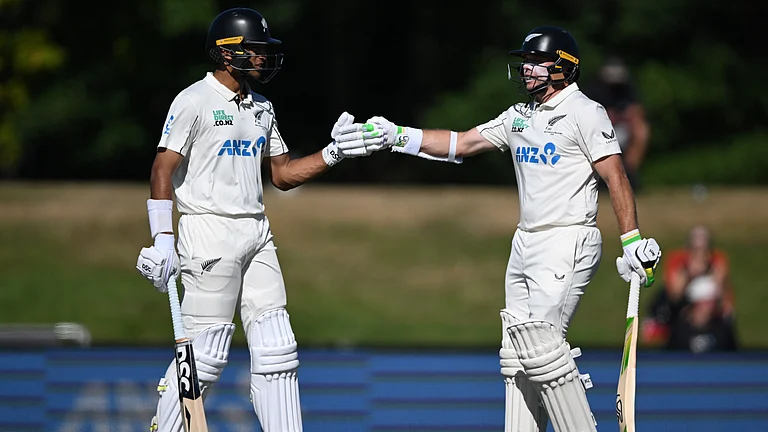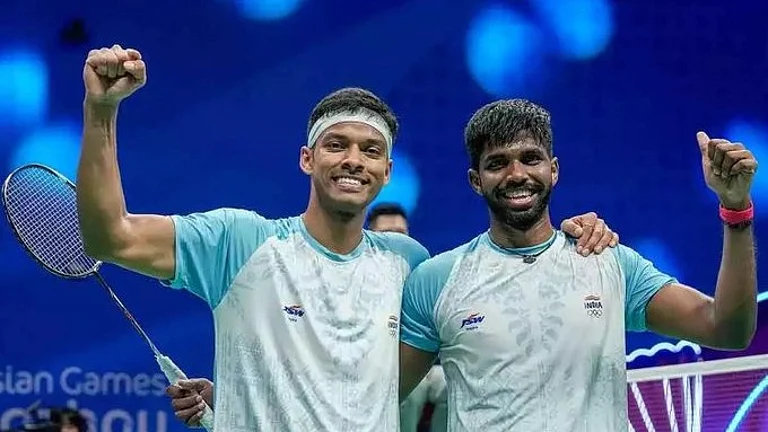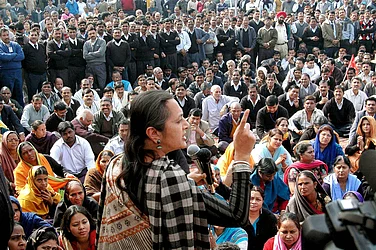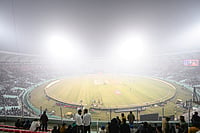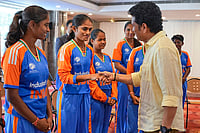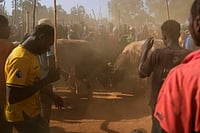In the five decades following Independence, the political imagination of the Congress and the socialist parties mattered most in the electoral arena of Karnataka. Land reforms, inclusive caste representation in public institutions, political decentralisation and policy regard for farmers’ welfare figured prominently on the political horizon during this time. In the 70s and the 80s, the farmer and Dalit movements strengthened the space for public discussions of rural well-being and caste equality.
The 90s saw dramatic shifts in the political horizon of Karnataka. In the wake of the new economic reforms at the centre, the service industry, in particular, the Information Technology (IT) sector, found enthusiastic policy support in Karnataka. The deregulation of the economy and the public-private partnerships were sported as new ideals of governance.
The BJP’s Rise
The Hindu nationalism of the BJP came to grab space in the electoral imagination towards the close of the nineties. Winning 13 seats in the 1998 Lok Sabha elections through an alliance with Lok Shakti, a party Ramakrishna Hegde formed in 1997 following his expulsion from Janata Dal, and 63 seats in the 1999 state assembly elections through an alliance with the J.H. Patel-led Janata Dal (U), the BJP began to acquire a concrete electoral presence in Karnataka. An opportunity to form a coalition government with the H.D. Kumaraswamy-led Janata Dal (S) in 2006 inaugurated for the BJP a phase of electoral consolidation that is still underway.
It is noteworthy that among the five southern states only Karnataka came to see the rise of the BJP. The party’s efforts to mobilise local voters on the anti-Muslim and anti-Christian planks worked in its favour. Some of the instances include the belligerent campaigns to hoist the Indian flag at the Idgah Maidan in Hubli in the early 90s, claiming the Sufi-Hindu Bababudangiri shrine in Chikmagalur as exclusively Hindu in the late 90s and the attacks on churches in Mangalore seen a decade later.
It is also essential to note the BJP’s success to acquire gradual control over the print and electronic media. Nearly all of the Kannada TV news channels are pro-BJP at present. While the Congress’ effort to set up its own TV news channel was short-lived, the one owned by the JD(S) has been unable to cultivate a sizable audience. Of the eight prominent Kannada daily newspapers, six are pro-BJP.
Acquiring New Community Allies
The BJP inherited Lingayat support in Karnataka, especially in the northern parts, through its political alliances with Ramakrishna Hegde and J.H. Patel and the leadership of B.S. Yediyurappa, a Lingayat. Garnering the support of Brahmin communities alongside, it has made determined efforts to find support from other communities.
During his tenure as Deputy Chief Minister, Yediyurappa started provisioning financial grants to various Hindu mutts and temples for ‘development’ work in the state’s budget, a practice that has since become a recurring feature in BJP-led governments in the state.
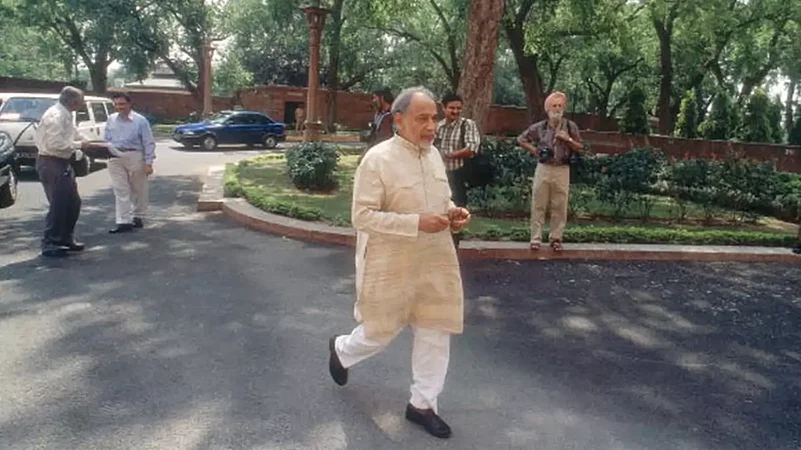
Last month, Chief Minister Basavaraj Bommai set aside Rs 1,000 crore for disbursement to nearly 500 local religious institutions. The BJP government has also launched welfare schemes aimed at the many electorally significant backward castes in Karnataka. Since 2019, it has formed development boards for over a dozen forward as well as backward castes.
It recently announced a hike in the reserved quota for Scheduled Tribes from three per cent to seven per cent, a move that is likely to enhance voter support in the 15 assembly constituencies reserved for them.
With the Congress enjoying the electoral backing of the ‘right-hand’ Dalit castes (historically more privileged), the BJP has sought to win over the equally large ‘left-hand’ Dalit castes (the most oppressed) to its side.
A week before the polling date was announced, Bommai announced that his government would implement the long-standing demand of the left-hand Dalits for internal reservations, a measure which would break up the reservation quota for Scheduled Castes into demographically proportional sub-quotas for the right-hand Dalits, the left-hand Dalits, the touchable Dalits and the other Dalits.
While this move will go down well with the left-hand Dalits, the BJP risks losing the support of the touchable Dalits, who are economically better off and do not experience untouchability even if they are socially low in status, since they will now need to reconcile to a restricted share of the reserved quota.
The Opposition Space
In the four years of the BJP-led government, the unceasing coldness between Siddaramaiah, the Congress leader, and H.D. Kumaraswamy, the JD(S) leader, made for disunity and incoherence in the opposition space. The bitterness, distrust and one-upmanship between these two leaders pre-empted any show of solidarity between the Congress and the JD(S) inside the Assembly or even outside.
Keen to maintain their separateness, their criticism of the ruling BJP government rarely found joint articulation. Indeed, their attack on the ruling party could on occasion extend towards each other. The wish to appear the truer Opposition party saw an absence of synergy when the Congress and the JD(S) took on the ruling party for its poor handling of the COVID crisis, for its ban on wearing the hijab in classrooms, for the complicity of its top leaders in the bitcoin scandal, for the bribery scam found in the recruitment of police constables and the numerous other cases of corruption, which culminated in acquiring the epithet of “40 per cent sarkara” for the state BJP government.
The desire among the Congress and the JD(S) to fight alone at all times without a care towards evolving even a working relationship among themselves showed their total unfamiliarity with a culture of coordinated opposition, whose value in a multi-party polity should be plainly obvious.
Anti-incumbency?
Unemployment, rising prices of essential goods and malicious targeting of local Muslims are among the serious problems on the ground. What stands out as a chief problem for the BJP-led state government, however, is massive corruption. Will these issues stay electorally significant until the time of the elections?
While a section of those affected by these issues won’t forgive the government easily, others might prioritise their concerns differently, especially if the Opposition parties don’t appear to them as an alternative to address their problems.
Barring a few constituencies, where individual candidates from the BJP are trusted to protect their interests, the Muslims and Christians, who form around 15 per cent of Karnataka’s population, will not want the BJP to be re-elected. Poor road quality and the flooding of the main roads during the rains have drawn severe public criticism in the 28-constituency strong Bengaluru city. The determination and the imaginativeness of the election campaigns of the Opposition parties will play a part though in whether and how the anti-incumbency will pan out at the voting booths.
A Saturation Point For The BJP?
The Congress is the only party with a pan-Karnataka reach, albeit with varying intensity of electoral presence across the different regions of the state. And, barring a few constituencies in the Hyderabad-Karnataka region, the influence of the JD(S) is mostly confined to the old Mysuru region, which consists of 61 constituencies.
Despite the large electoral support in North Karnataka owing to the backing of the Lingayat community; in the coastal region, which hosts a strong Hindutva base, and in Bengaluru city, whose electorate has shown an inclination towards the BJP, the party hasn’t ever won a majority on its own in Karnataka. The inability to find voter support among the large Vokkaliga community, in particular, in the Old Mysuru region, where they make up over 40 per cent of the population, is a key factor in this regard. This community has felt comfortable choosing between the JD(S) and the Congress. Indeed, JD(S) leader Deve Gowda is the tallest Vokkaliga leader at present.

The meat-eating farmer community’s cultural rootedness and political self-confidence has also meant an indifference to the ideological gambit of the BJP. Further, the ethos of inter-community understanding that has evolved between the people of different faiths in Old Mysuru during the rule of the Wodeyars and that of Tipu Sultan before them also explains the limited appeal of Hindutva politics.
Faced with these cultural facts of the Mysuru region, the BJP had focused its mobilisational efforts elsewhere in the state. With an aim to shed its heavy dependence on the Lingayat community, increasing its seat share in the assembly and also acquiring a pan-Karnataka presence, it has been making aggressive efforts to find a foothold in the Vokkaliga heartland.
Installing a giant-sized statue of Kempegowda, the founder of Bengaluru, at the city’s international airport was one of these efforts. The short-lived campaign to mobilise the Vokkaligas on an anti-Muslim plank by claiming falsely that two Vokkaliga chieftains had killed Tipu Sultan on the battlefield was another.
Recently, Bommai removed the four per cent reservation that Muslims were entitled to and divided it equally between the Lingayats and the Vokkaligas. While these two communities will need to split their new quota share with other communities, and CM’s decision is not likely to stand judicial scrutiny due to the lack of evidence to show that Muslims were no longer socially and educationally backward, the move does offer a glimpse into the nature of the BJP’s electoral zeal.
Late last year, when the Union Minister of Cooperation, Amit Shah, declared that Amul and Nandini, the brand owned by Karnataka Milk Federation, the second largest milk co-operative in India, would jointly procure milk in every village of Karnataka, it elicited sharp criticism locally, including from the Congress and the JD(S) leaders. The recent decision of Amul to sell fresh milk and curd in Bengaluru, therefore, saw widespread anger that this move was paving the way for the merger of the home-grown Nandini brand with Amul. Discerning a motive to bring the lakhs of milk-producing rural households, most of whom are in the old Mysuru region, under the control of the Central Government with direct implications for local voting patterns, the Congress and the JD(S) attacked the BJP for its aim to undermine federal autonomy.
For reasons hard to tell, the BJP’s desire to cultivate electoral support from the Vokkaligas and left-hand Dalits has gone along with recklessness towards its Lingayat support base. The factionalism within the state BJP has seen Yediyurappa step down as chief minister in 2021 and denied tickets last week to two major Lingayat leaders, former chief minister Jagadish Shettar and former Deputy Chief Minister Laxman Savadi, both of whom will now contest from the Congress, improving the Congress’s chances of securing greater support from the Lingayats.
Fielding a few of the rebel candidates from the Congress and the BJP in north Karnataka, the JD(S) is likely to win a few seats in a region where it was likely to not fare very well. The Aam Aadmi Party (AAP), which is contesting the state elections for the second time, has fielded over 150 candidates. Its influence is restricted to Bengaluru, and it is not likely to win a seat, but the performance of this national party’s merits attention.
The elections next month matter differently to different political parties. An improved seat tally for the JD(S) means it can continue to sit confidently in the opposition and inherit a chance perhaps at being a part of any post-election coalition arrangement.
Emerging as the single-largest party with a clear or even slim majority will give Congress a chance to form the government and also shore up the party’s morale as it gears up for the 2024 Lok Sabha elections. And, winning a respectable number of seats or an electoral victory for the BJP will mean that religious and caste considerations and Prime Minister Narendra Modi’s appeal have mattered for their voters above all else.
Money and media influence have come to matter more and more in elections in Karnataka and the three main political parties in the state do not possess them in equal amounts. So these unholy facts should also matter when we make sense of the upcoming Assembly election.
Chandan Gowda is Ramakrishna Hegde chair Professor, Institute for Social and Economic Change, Bengaluru








